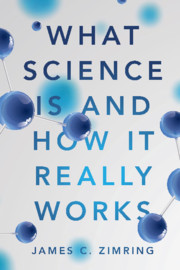Book contents
- What Science Is and How It Really Works
- What Science Is and How It Really Works
- Copyright page
- Dedication
- Contents
- Acknowledgments
- Introduction
- Part I
- Part II
- Part III
- 9 Remedies That Science Uses to Compensate for How Humans Tend to Make Errors
- 10 The Analysis of a Phantom Apparition, or Has Science Really Been Studied Yet?
- 11 The Societal Factor, or How Social Dynamics Affect Science
- 12 A Holistic World of Scientific Entities, or Considering the Forest and the Trees Together
- 13 Putting It All Together to Describe “What Science Is and How It Really Works”
- About the Author
- Index
13 - Putting It All Together to Describe “What Science Is and How It Really Works”
from Part III
Published online by Cambridge University Press: 04 July 2019
- What Science Is and How It Really Works
- What Science Is and How It Really Works
- Copyright page
- Dedication
- Contents
- Acknowledgments
- Introduction
- Part I
- Part II
- Part III
- 9 Remedies That Science Uses to Compensate for How Humans Tend to Make Errors
- 10 The Analysis of a Phantom Apparition, or Has Science Really Been Studied Yet?
- 11 The Societal Factor, or How Social Dynamics Affect Science
- 12 A Holistic World of Scientific Entities, or Considering the Forest and the Trees Together
- 13 Putting It All Together to Describe “What Science Is and How It Really Works”
- About the Author
- Index
Summary
Based on the discussions in this book, the following definition of science is suggested to my fellow scientists and nonscientists alike. First and foremost, science is an outgrowth of normal human observation, reasoning, conclusion, and prediction. Scientists and nonscientists both depend upon induction and the assumptions it entails – assumptions that are imperfect and don’t always hold. They assume that the future will resemble the past to a greater extent than by guessing alone, and they also assume that what one has encountered today is more representative of things not yet encountered than can be arrived at by random guessing. Both scientists and nonscientists retroduce causes for the effects they observe, a form of reasoning that suffers from the fallacy of affirming the consequent. As a result of this fallacy, scientists and nonscientists both retroduce hypotheses of causal things that likely never existed, such as phlogiston being the cause of heat, a vital force being required for the types of chemicals that come from living things, and the great Sananda causing a prophet’s pen to write. One needs ongoing observation, and if possible experimentation, to further assess which retroduced causes one should hold onto (at least for now) and which should be rejected (at least for now). Scientists and nonscientists both use deduction (or at least a form of reasoning that resembles deduction but may not adhere to strict standards of formal logic) to make further predictions based on their retroduced hypotheses. Scientists and nonscientists both have fallacies in their hypothetico-deductive (HD) thinking, make mistaken observations, have cognitive biases, and fall in love with their hypotheses, noticing observations that confirm and ignoring observations that refute. Scientists and nonscientists are both susceptible to social pressures, social biases, and manipulation (intentional and unintentional) by the groups and societies in which they find themselves.
- Type
- Chapter
- Information
- What Science Is and How It Really Works , pp. 353 - 380Publisher: Cambridge University PressPrint publication year: 2019



